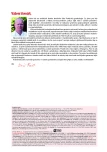-
Medical journals
- Career
Hysteroscopic sterilization by system Essure in gynecologic practice: new technology of permanent contraception
Authors: Petr Kovář 1; Jana Kučerová 2; Magda Szewczyk 2
Authors‘ workplace: Katedra chirurgických oborů (gynekologie), Lékařská fakulta Ostravské univerzity v Ostravě, vedoucí katedry doc. MUDr. Jan Dostalík, CSc. 1; Gynprenatal s. r. o., Havířov, vedoucí lékař MUDr. Petr Kovář 2
Published in: Prakt Gyn 2013; 17(3): 220-225
Category: Gynecology and Obstetrics: Original Article
Overview
Introduction:
Sterilization as a form of permanent non-hormonal contraception is not a frequently used method in Czech Republic. Last year the old juridical regulation changed and in April 2012 a new law entered validity, it makes sterilization possible for everyone who is older than 21. The only option to sterilize a woman was through a surgery procedure in general anaesthesia.Aim:
We are introducing a new accessible method of office sterilization by system Essure. We are presenting a comparison of laparoscopic and hysteroscopic sterilization.Methods and results:
Summary of worldwide experience of more than 650 000 sterilizations using the method Essure. Evaluation of the first application in the Czech Republic.Conclusion:
In these days sterilization is a discussed theme, the new law has brought a lot of questions, which are being gradually clarified. We believe this modern and elegant method used in gynecologic practice will find its strong positionKey words:
Essure – hysteroscopic sterilization in gynecologic practice – laparoscopic sterilization – new legislation
Sources
1. Peréz-Medina T, Font EC. Diagnostic and Operative Hysteroscopy. 2nd ed. JaypeeBrothers Medical Publishers: New Delhi – London 2012. ISBN 987–93–80704–69–2.
2. Chern B, Siow A. Initial Asian experience in hysteroscopic sterilisation using the Essure permanent birth control device. BJOG 2005; 112(9): 1322–1327.
3. Essure permanent birth control (oficiální webové stránky). Dostupné z WWW: < http://www.essuremd.com>.
4. Palmer SN, Greenberg JA. Transcervical sterilization: a comparison of essure permanent birth control system and adiana permanent contraception system. Rev Obstet Gynecol 2009; 2(2): 84–92.
5. Kessel E. 100,000 quinacrine sterilizations. Adv Contracept 1996; 12(2): 69–76.
6. Sokal DC, Hieu do T, Loan ND, Hubacher D et al. Contraceptive effectiveness of two insertions of quinacrine: results of 10 years follow up in Vietnam. Contraception 2008; 78(1): 61–65.
7. Sokal DC, Vach TH, Nanda K et al. Quinacrine sterilization and gynecologic cancers: a case report study in northern Vietnam. Epidemiology 2010; 21(2): 164–171.
8. Valle RF, Carignan CS, Wright TC (STOP Prehysterectomy Investigation Group). Tissue response to the Stop microcoil transcervical permanent contraceptive device: results from prehysterectomy study. Fertil Steril 2001; 76(5): 974–980.
9. Kerin JF, Cooper JM, Price T et al. Hysteroscopic sterilization using a micro-insert device: results of multicentre Phase II study. Human Reprod 2003; 18(6): 1223–1230.
10. Kerin JF, Carignan CS, Cher D. The safety and effectiveness of a new hysteroscopic method for permanent birth control: results of the first Essure pbc clinical study. Aust N Z J Obstet Gynaecol 2001; 41(4): 364–370.
11. Bližší informace jsou dostupné z WWW: <http://www.essure.com/is-essure-right-for-me/insurance-coverage>.
12. Arjona JE, Miño M, Cordón P et al. Satisfaction and tolerance with office hysteroscopic tubal sterilization. Fertil Steril 2008; 90(4): 1182–1186.
13. Lessard CR, Hopkins MR. Efficacy, safety and patient acceptability of EssureTM procedure. Patient Prefer Adherence 2011; 5 : 207–212.
14. Kerin JF. Pregnancies in women who have the Essure hysteroscopic sterilization procedure: a summary of 37 cases. J Minim Invasive Gynecol 2005; 12(Suppl): S28. Abstract 67.
15. Levy B, Levie MD, Childers ME. Summary of reported pregnancies after hysteroscopic sterilization. J Minim Invasive Gynecol 2007; 14(3): 271–274.
16. Rosenfield RB, Stones RE, Coates A et al. Proximal occlusion of hydrosalpinx by hysteroscopic placement of microinsert before in vitro fertilization-embryo transfer. Fertil Steril 2005; 83(5): 1547–1550.
17. Mijatovic V, Veersema S, Emanuel MH et al. Essure hysteroscopic tubal occlusion device for the treatment of hydrosalpinx prior to in vitro fertilization-embryo transfer in patients with a contraindication for laparoscopy. Fertil Steril 2010; 93(4): 1338–1342.
18. Shellock FG. New metallic implant used for permanent contraception in women: evaluation of MR safety. Am J Roentgenol 2002; 178(6): 1513–1516.
19. Donnadieu AC, Fernandéz H. The role of EssureTM sterilization performed simultaneuously with endometrial ablation. Curr Opin Obstet Gynecol 2008; 20(4): 359–363.
20. Uzel R, Kovář P. Antikoncepční otazníky: o antikoncepci převážně vážně. CAT Publishing: Ostrava 2010. ISBN 978–80–904290–0–0.
21. Hopkins MR, Creedon DJ, Wagie AE et al. Retrospective cost analysis comparing Essure hysteroscopic sterilization and laparoscopic bilateral tubal coagulation. J Minim Invasive Gynecol 2007; 14(1): 97–102.
22. Duffy S, Marsh F, Rogerson L et al. Female sterilization: a cohort controlled comparative study of Essure versus laparoscopic sterilisation. BJOG 2005; 112(11): 1522–1528.
23. Ministerstvo zdravotnictví, Sbírka zákonů 2011, Zákon o specifických zdravotních službách, 373/2011, § 12–16.
24. Ministerstvo zdravotnictví, Sbírka zákonů 2012, Vyhláška o zrušení směrnice Ministerstva zdravotnictví České socialistické republiky č. 1/1972 Věstník MZ ČSR, o provádění sterilizace, č. 340
Labels
Paediatric gynaecology Gynaecology and obstetrics Reproduction medicine
Article was published inPractical Gynecology

2013 Issue 3-
All articles in this issue
- Efficiency of bevacizumab in treatment for relapsing ovarian cancer: case report
- Resveratrol in oncogynecology
- Hysteroscopic sterilization by system Essure in gynecologic practice: new technology of permanent contraception
- When to refer a patient to venerologist?
- Innovations in polycystic ovary syndrome study
- Antiadhesive agents in laparoscopic surgery
- Czech urogynecology in 21th century
- Determinants of health literacy of pregnant women
- XIth World Congress of Perinatal Medicine
- 10th Congress of European Society of Gynecology
- Practical Gynecology
- Journal archive
- Current issue
- Online only
- About the journal
Most read in this issue- Hysteroscopic sterilization by system Essure in gynecologic practice: new technology of permanent contraception
- Antiadhesive agents in laparoscopic surgery
- When to refer a patient to venerologist?
- Innovations in polycystic ovary syndrome study
Login#ADS_BOTTOM_SCRIPTS#Forgotten passwordEnter the email address that you registered with. We will send you instructions on how to set a new password.
- Career

